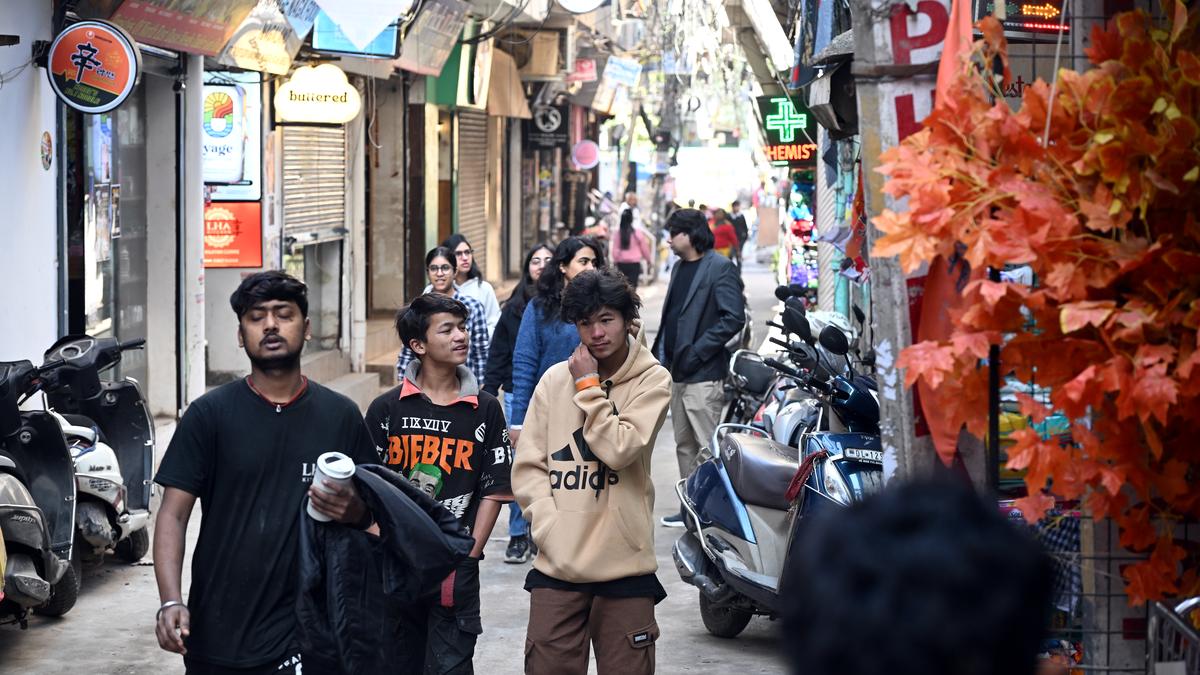People at Humayunpur Village in Safdarjung Enclave complained that authorities overlook issues like exorbitant rent and poor amenities.
| Photo Credit: SUSHIL KUMAR VERMA
Nestled inside south Delhi’s Safdarjung Enclave, Humayunpur, a predominantly Jaat-dominated village, is now home to hundreds of migrants from Northeast India who are generally students, office-goers, or restaurateurs.
Most of them, who migrated to Delhi for better opportunities, “feel neglected”. Issues like exorbitant rent and poor amenities “are overlooked by the authorities” as they are not residents of Delhi, they complain.
“I took a shop and a tiny room adjacent to it on rent, and it cost me ₹30,000. The landlord increased the rent to ₹35,000 in a few months. There is no forum where we can raise our concerns. Housing has become unaffordable. I want to bring my children to Delhi for better education, but I fear for their survival. Only a little I manage to save every month,” said Botoka Shoha, a native of Nagaland. The 32-year-old woman living with her husband sells groceries and vegetables at Humayunpur.
Isaha recently migrated to Delhi from Arunachal Pradesh. She works at a cafe in Humayunpur and regrets her decision to come to the Capital.
“The opportunities here [Delhi] are limited. Some of my friends live in Bengaluru, Noida and Gurugram and are satisfied. There is hardly any MNC left in Delhi. The infrastructure is poor, and everything is costly. My next aim is to move out of Delhi and settle elsewhere,” said the 21-year-old woman.
According to several elders at Humayunpur, in the 1960s, the agricultural land around the village was acquired and Safdarjung Enclave was developed. The village was left with the residential areas.
During the IT boom in the early 2000s, when the NCR region was still underdeveloped and people from all over the country were migrating to Delhi to work at MNCs, Humayunpur was among the few places that attracted them due to its location and reasonable prices.
Initially, few migrants from the Northeast arrived, but soon, their numbers swelled. Gradually, the villagers turned their single-storey houses into buildings that provided rooms and shops for rent.
Today, the village houses a mini market with cafes and restaurants offering Northeastern food and shops selling clothes, groceries and other essentials. Moving around Humayunpur, the cafes and neon lights can capture the hip-hop culture. However, pothole-ridden roads, poor drainage, and loose wires dangling over spoil the essence.
Pooja, 39, a Nepali woman, told The Hindu that locals manage cleanliness as civic bodies’ sanitation workers rarely visit. “The drainage system often remains blocked. We have to hire private sanitation workers to get the sewage cleared,” she complained.
Humayunpur falls under the Malviya Nagar Assembly, which has been represented by Aam Aadmi Party’s Somnath Bharti since 2013. Seeking re-election, Mr. Bharti will take on BJP’s Satish Upadhyay and Congress’s Jitendra Kumar Kochar.
Majnu Ka Tila
Another locality dominated by Northeast migrants is Majnu Ka Tila or New Aruna Nagar. Initially home to Tibetan refugees who arrived in 1959, Majnu Ka Tila now houses hundreds of northeast migrants as well.
The residents highlighted the key problem of flooding during monsoons due to the area’s proximity to the Yamuna River.
“We hope the government will listen to our grievances and improve anti-flood measures and water drainage system. Many among us are non-voters, but we contribute to Delhi’s development through taxes. Our concerns shouldn’t be ignored,” said Roma, 40, a native of Assam, who came to Delhi 40 years ago.
Majnu Ka Tila is part of the Chandni Chowk Assembly, and AAP has replaced its sitting MLA, Parlad Singh Sawhney, with Punardeep Singh Sawhney. The BJP has fielded Satish Jain, while Mudit Agarwal will contest from the Congress.
Published – February 05, 2025 01:53 am IST
